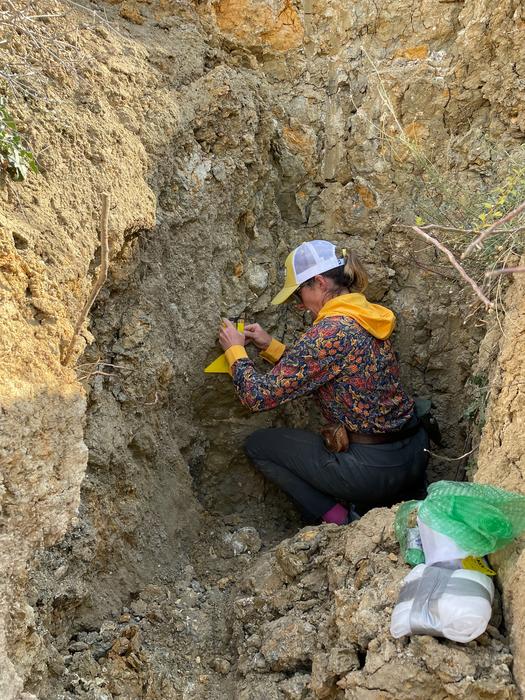
image:
During an NSF-funded trip to the M7.6 earthquake rupture site near Içmeler, Turkey in 2023, Utah State University geoscientist Alexis Ault measures the orientation of the rupture interface and prepares to take samples. Ault is lead principal investigator on a $2.3M NSF-funded multi-institution collaborative project to study earthquake critical zones in the U.S. and abroad.
view more
Credit: Sinan Akçiz, CSU, Fullerton
LOGAN, UTAH, USA — Utah State University geoscientist Alexis Ault recalls the devastating aftermath of back-to-back 7.8 and 7.6-magnitude earthquakes on Feb. 6, 2023, near the Turkey-Syria border that killed more than 50,000 people and displaced millions.
“We witnessed the destruction firsthand, as well as the resilience of the country and population trying to get their footing and rebuild,” says Ault, associate professor in USU’s Department of Geosciences, who traveled to the disaster site about six months after the catastrophic quakes. “It was heartbreaking, but also inspiring.”
Unfortunately, she says, Turkey is among many countries that repeatedly experience large and damaging earthquakes on an unpredictable basis. Her colleague Brady Cox, founding director of USU’s Earthquake Engineering Research Center, has also observed calamitous human suffering and infrastructure damage during the past 25 years following earthquakes in the United States and abroad. Citizens of Utah, says Cox, professor in USU’s Department of Civil and Environmental Engineering, are also at risk from a significant — and potentially overdue — earthquake along the Wasatch Fault.
Understanding the earthquake cycle processes that portend such powerful forces and how to mitigate their risk is at the core of a research project Ault is undertaking with Cox and USU Geosciences colleagues Dennis Newell and Srisharan Shreedharn, along with Brown University geophysicist Greg Hirth and California State University, Fullerton geologist Sinan Akçiz. The team was awarded a $2.3 million Frontier Research in Earth Sciences (FRES) grant from the U.S. National Science Foundation to pursue the five-year project.
Ault, Newell and Akçiz’s trip to the 2023 7.6-magnitude quake site, funded by an NSF Rapid Response Research grant, enabled them to collect fragile samples from the earthquake’s rupture interface along the Çardak-Yesilyurt Fault system, along with measuring gas flux along the rupture.
“Those delicate samples, which are no longer possible to acquire because the rupture interface erodes with time, provide critical materials for the current study,” says Newell, professor and interim head of USU’s Department of Geosciences.
The Çardak-Yesilyurt rupture samples, along with samples and shallow geophysical data the researchers have collected from California’s southern San Andreas fault, will help the team investigate how the earthquake critical zone — the near-surface layer of the Earth’s restless crust — accumulates and releases earthquake energy on major strike-slip faults. Ault notes acquisition of geophysical data across the San Andreas fault, led by Cox, was made possible by USU faculty Seed Grants awarded to Ault and Cox.
Ault says, unlike the fault in Turkey, the San Andreas fault is overdue for an earthquake.
“This NSF-funded project will help us overcome limitations of previous, generalized characterizations of earthquake critical zones with more in-depth geologic data, seismic imaging studies, deformation experiments and modeling,” she says. “Combining expertise from varied engineering and geoscience disciplines, we aim to emerge with a more complete and accurate picture of earthquake critical zones in these settings.”
The team plans to leverage NSF-supported, shared-use equipment and data archiving resources from the Natural Hazards Engineering Research Infrastructure (NHERI) program and USU’s new Rock Deformation and Earthquake Mechanics Lab, the latter of which is led by co-PI Shreedharan.
“By deforming these one-of-a-kind samples in the Rock Deformation and Earthquake Mechanics Lab under the same pressures that they experienced in the near-surface crust, we can begin to understand how, where and over what timescales strike-slip fault zones like the San Andreas and Çardak-Yesilyurt accumulate strain energy,” he says.
Centered on concepts of intellectual, educational and cultural reciprocity, the project involves international collaboration with researchers in Turkey. It also affords substantial learning and training opportunities for mentees. These include positions for three doctoral students and two postdoctoral fellows at Utah State, a doctoral student and postdoctoral fellow at Brown, and a master’s student position at CSUF, as well as multiple research opportunities for undergraduate researchers at each of the participating institutions.
In addition, the grant bolsters the USU team’s ongoing efforts with the university’s Native American Summer Mentorship Program, which encourages Aggie undergrads at the USU Blanding campus to pursue research and four-year degree programs.
“This project has the potential to benefit communities from multiple angles, including improving earthquake hazard models and seismic site response analyses to better protect human life, to providing meaningful educational opportunities in Earth sciences and engineering, as well as strengthening international partnerships,” Ault says.
Disclaimer: AAAS and EurekAlert! are not responsible for the accuracy of news releases posted to EurekAlert! by contributing institutions or for the use of any information through the EurekAlert system.
Source link : http://www.bing.com/news/apiclick.aspx?ref=FexRss&aid=&tid=66b56155ac27407896a6eceb7a16c5b1&url=https%3A%2F%2Fwww.eurekalert.org%2Fnews-releases%2F1054108&c=2750144305648003899&mkt=en-us
Author :
Publish date : 2024-08-08 12:27:00
Copyright for syndicated content belongs to the linked Source.